Preserving fertility in early cervical Ca with radical trachelectomy
Childbearing is no longer precluded for eligible women with stage IB cervical cancer who undergo this procedure. At some institutions, this alternative has already become standard of care.
RADICAL TRACHELECTOMY
Preserving fertility in early cervical Ca with radical trachelectomy
By Allan Covens, MD
Childbearing is no longer precluded for eligible women with stage IB cervical cancer who undergo this procedure. At some institutions, this alternative has already become standard of care.
A relatively new fertility-preserving procedure is gaining worldwide acceptance as an effective way to surgically manage small invasive cervical cancers. Radical vaginal trachelectomy after laparoscopic pelvic lymphadenectomy involves removing mostor allof the cervix, its contiguous parametrium, and vaginal cuff, after first removing and examining lymph nodes. In 1994, Dargent first described the procedure in France and then presented his data before the Society of Gynecologic Oncologists.1 Several other presentations and publications followed.2-5
The rationale for this procedure is based on the fact that some 15% of all cervical cancers and 45% of surgically treated stage IB cervical cancers occur in women under age 40.6 Consequently, a significant proportion of women will not have completed childbearing and could be eligible for a fertility-sparing procedure. Additionally, we can clinically identify a portion of these women who, due to their low likelihood of lymph node spread and recurrence, are unlikely to require postoperative adjuvant therapy and for whom preserving the uterus probably will not compromise survival.
The other fertility-preserving procedures that have been describedcone biopsy alone or combined with pelvic lymphadenectomy, ovarian transposition and intracavitary radiation therapy, and chemotherapy followed by cone biopsyare beyond the scope of this review.7,8 Given that many gynecologic oncologists are unfamiliar with radical vaginal surgery, several investigators have described abdominal radical trachelectomy.9,10 However, very few women have undergone this procedure. Because radical vaginal trachelectomy, as Dargent described the procedure, permits women to become pregnant without resorting to assisted reproductive technology such as in vitro fertilization, it appears to be an ideal approach for them. The theoretical data supporting the procedure include the fact that cervical cancer tends to spread laterally from the cervix, hence the removal of the contiguous parametrium and vagina (as performed in radical hysterectomy). In addition, small stage IB cervical cancers rarely spread superiorly into the uterus, and for the most part, their spread tends to be contiguous, rather than discontiguous.
Beginning the lymphadenectomy
The surgical procedure begins with a laparoscopic lymphadenectomy (Figure 1), which can be done by either a transperitoneal or retroperitoneal approach. Alternately, surgeons unskilled in laparoscopy can perform this part of the surgery via an extraperitoneal dissection. Although some surgeons submit all of the lymph nodes for frozen section, we do not routinely do so for the following reason. Given the low incidence of nodal metastases in these patients, and the likelihood that chemoradiation will be recommended if nodal metastases are identified whether or not a patient has undergone a radical hysterectomy, the patient's outcome and treatment should not be compromised by performing the radical trachelectomy.
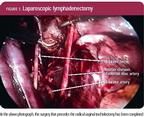
Next, a cuff of vagina is identified and incised, and the paravesical, rectovaginal, and vesicovaginal spaces are dissected. The distal portions of the cardinal and uterosacral ligaments are then clamped and divided, usually in their mid-portion. The surgeon identifies the ureter in the uterovesical ligamentinitially by palpation and subsequently by visualizationwhich enables the ligament distal to the ureter to be safely transected (Figure 2).
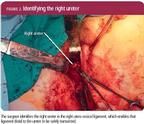
The next step is to ligate the vaginal branch of the uterine artery (Figure 3), and transect the cervix where it meets the uterine isthmus (Figure 4). Most centers routinely perform a frozen section on the superior margin of the cervix to confirm a minimum of 5 mm tumor clearance. For those patients whose margins appear to be less than the minimum, the surgeon further resects the cervix and lower uterine segment until the above criterion is met. In our center, we insert a No. 8F rubber catheter and suture it into the os of the "neocervix" to maintain patency (Figure 5). This is removed 3 weeks postoperatively. To prevent mid-trimester loss due to cervical incompetence, we place a Mersilene suture (Shirodkar) around the lower uterine segment. Finally, we suture the vaginal cuff to the most lateral portions of the "neocervix" while burying the Mersilene suture (Figure 5).

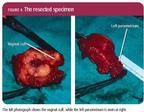
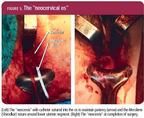
Follow-up visits are every 3 months for 2 years, then every 6 months for 3 years, and finally yearly. Each visit entails a Pap test and colposcopy in addition to the usual history and physical exam (Figure 6). At most centers, conception is not proscribed for any specific time, barring high-risk features that warrant adjuvant chemoradiation (positive pelvic lymph nodes or deep invasion in combination with vascular space invasion).11 In patients who do become pregnant, the Shirodkar suture requires delivery via caesarean section.
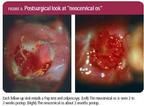
Major centers' experiences with trachelectomy
To date, four major centers have had the majority of experience with this procedure worldwide.2-5 The following tables include the latest data from our center, while those from Dargent, Roy, and Shepherd reflect data presented and published from the VIII International Gynecologic Cancer Society meeting in 2000.8
Although typically the procedure has been restricted to patients with tumors that are 2 cm or less, a small number of women with larger tumors have also undergone it (Table 1). The rationale for deciding which women with larger tumors are eligible for the procedure hinges on whether those patients will likely have high-risk features for recurrence that would require recommending postoperative adjuvant therapy. Rarely, women who have exophytic adenocarcinomas with little stromal invasion may be reasonable candidates for this procedure, irrespective of tumor size. For example, our series included one patient with a 5-cm exophytic "mushroom-shaped" minimally invasive adenocarcinoma. All of her lymph nodes were negative and she has remained recurrence-free for 30 months.
TABLE 1
Patient demographics
It's also possible to perform this procedure on pregnant patients in the first trimester, as Dargent has done on five patients, three of whom have gone on to term pregnancies. At our institution, too, we've performed radical vaginal trachelectomies on two pregnant women, one of whom carried a pregnancy to term. As Table 1 shows, the four major centers have been very successful in clinically identifying patients at low risk for lymph node metastases.
Table 2 summarizes operative details. In comparison to radical hysterectomy, blood loss and hospital stay are very low, while operative time is longer. Hospital stays are much shorter in North American than in European centers. Operative and postoperative complications have occurred. Most complicationswhich include vascular and obturator nerve injurieshave resulted from the laparoscopic pelvic lymphadenectomy portion of the procedure and probably reflect the learning curve for laparoscopic surgery. Complications from the vaginal approach are cervical stenosis leading to hematometra, cystotomies, ureteral injuries, and rectal injury from Schuchardt's incisions. As with all surgery, we anticipate that these will decrease with experience.
TABLE 2
Operative details
Is trachelectomy as effective as radical hysterectomy?
Proof that this procedure is as effective as radical hysterectomy is a major issue for many. But a randomized study is not feasible, given the small population of patients eligible to undergo the surgery, the biases expressed by eligible patients desperately wishing to preserve fertility, the few surgeons skilled in performing it, and the small differences in recurrence that researchers would need to detect. Therefore, efficacy will likely have to come from pooled series of patients treated and compared to historical controls.
In 1999, we reported on 32 patients treated by radical vaginal trachelectomy and compared them to matched controls and a large population of unmatched ones.3 In that paper, we could identify no significant differences between patients thus treated and either control group. In Table 3, which gives outcome data for recurrence and fertility, pooled data demonstrate a 3% recurrence rate. A portion of patients who have a recurrence can be salvaged with radiation therapy (isolated pelvic recurrence) as Dargent has shown.4 As the recurrence rate after radical hysterectomy is clearly not zero, we can never know whether some of these patients would have avoided a recurrence had they undergone a radical hysterectomy.
TABLE 3
Outcomes after radical vaginal trachelectomy
Dargent and Plante have both reported on patients with seemingly early cancers that had spread to the endometrium and myometrium, in some cases by discontiguous spread.8,12 Theoretically some of these patients' cancers might have recurred in the uterus after trachelectomy, but not radical hysterectomy. To date, however, no women who've undergone trachelectomy have had isolated recurrences in their uteri. The recurrence-free survival at 36 months in our patients is 96% (Figure 7).

Cone biopsy with pelvic lymphadenectomy has been suggested as a method of managing these patients. If one believes that removal of the parametrium is important in this disease, however, it becomes hard to justify. We have published arguments for and against removal of the parametrium at surgery for cervical cancers.13
Pooling the data from the four series (Table 3), 92 women have attempted to conceive after the procedure, resulting in 102 pregnancies (several patients have had more than one pregnancy) and culminating in 65 live births (excluding twins). We don't know the exact number of live births from Lyon and Quebec City, as only the totals have been published.8
At our center, on the other hand, we have been meticulous in tracking our patients' attempts at conception, achievement of pregnancy, and the outcomes. By 36 months, approximately 55% of our patients who attempted to conceive succeeded (Figure 8). Five women became pregnant via intrauterine insemination and three via IVF, while the remainder conceived naturally or took oral ovulation-inducing drugs. The majority of these women underwent C/S after 34 weeks' gestation; however, at each center the women had a high rate of preterm premature rupture of the membranes (PPROM). In our series, six of 18 pregnancies that continued beyond the 15 weeks ended prior to 36 weeks (two, however, were twin pregnancies). Shepherd's finding that seven of nine live births were preterm is thought by Dargent to be related to ascending chorioamnionitis due to an inadequate mucous plug.14
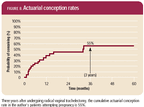
Dargent has therefore been performing a Saling procedure (surgical closure of the cervix) at 14 weeks' gestation.15 Whether such a maneuver reduces the incidence of PPROM or labor or both has not yet been elucidated.
Most investigators don't consider a history of infertility as an absolute contraindication to preserving fertility. In 1999, three of the four women whom we reported as becoming pregnant after this procedure had had a history of anovulation.3 Whether the fertility rate after this procedure is lower than that expected is unclear but probable. Potential causes of reduced fertility are subclinical salpingitis, adhesions, and absence of cervical mucus.
Clearly, in experienced hands, radical trachelectomy is a safe and feasible procedure to perform on women with small cervical carcinomas who wish to bear children. For many women, pregnancies resulting in live births and healthy babies are a proven realistic outcome. It's reassuring that the recurrence rate to date in the four largest series is not glaringly different from that anticipated after radical hysterectomy, even after taking the favorable pathology into account. At what point clinicians will accept this procedure as a standard of care option versus an experimental one for eligible patients will vary. The local expertise in cities like Toronto, Lyon, and Quebecwhere it is accepted as a standard of careis likely an influential factor. On the other hand, some clinicians may not be convinced until they see larger numbers of patients followed for longer periods of time.
REFERENCES
1. Dargent D, Brun JL, Roy M, et al. La trachélectomie elar (T.E.) une alternative à l'hystérectomie radicale dans le traitement des cancers infiltrants développés sur la face externe du col utérin. J Obstetrics et Gynecologie. 1994;2:285-292.
2. Roy M, Plante M. Pregnancies after radical vaginal trachelectomy for early-stage cervical cancer. Am J Obstet Gynecol. 1998;179:1491-1496.
3. Covens A, Shaw P, Murphy J, et al. Is radical trachelectomy a safe alternative to radical hysterectomy for patients with stage IA-B carcinoma of the cervix? Cancer. 1999;86:2273-2279.
4. Dargent D, Martin X, Sacchetoni A, et al. Laparoscopic vaginal radical trachelectomy: a treatment to preserve the fertility of cervical carcinoma patients. Cancer. 2000;88:1877-1882.
5. Shepherd JH, Crawford RA, Oram DH. Radical trachelectomy: a way to preserve fertility in the treatment of early cervical cancer. Br J Obstet Gynaecol. 1998;105:912-916.
6. Covens A, Rosen B, Murphy J, et al. Changes in the demographics and perioperative care of stage IA(2)/IB(1) cervical cancer over the past 16 years. Gynecol Oncol. 2001;81:133-137.
7. Covens AL, van der Putten HW, Fyles AW, et al. Laparoscopic ovarian transposition. Eur J Gynaecol Oncol. 1996;17:177-182.
8. Dargent D. Fertility Preserving Management of Early Stage Cancer of the Cervix. Monduzzi Editore. International Gynecologic Cancer Society Meeting, Buenos Aires, Argentina, 2000.
9. Rodriguez M, Guimares O, Rose PG. Radical abdominal trachelectomy and pelvic lymphadenectomy with uterine conservation and subsequent pregnancy in the treatment of early invasive cervical cancer. Am J Obstet Gynecol. 2001;185:370-374.
10. Smith JR, Boyle DC, Corless DJ, et al. Abdominal radical trachelectomy: a new surgical technique for the conservative management of cervical carcinoma. Br J Obstet Gynaecol. 1997;104:1196-1200.
11. Sedlis A, Bundy BN, Rotman MZ, et al. A randomized trial of pelvic radiation therapy versus no further therapy in selected patients with stage IB carcinoma of the cervix after radical hysterectomy and pelvic lymphadenectomy: A Gynecologic Oncology Group Study. Gynecol Oncol. 1999;73:177-183.
12. Plante M, Roy M. Pregnancies Following Radical Trachelectomy For The Treatment Of Early-Stage Cervical Cancer. Moduzzi Editore. International Gynecologic Cancer Society, Rome, Italy, 1999.
13. Covens A, Rosen B, Murphy J, et al. How important is removal of the parametrium at surgery for carcinoma of the cervix? Gynecol Oncol. 2002;84:145-149.
14. Plante M. Fertility preservation in the management of gynecologic cancers. Curr Opin Oncol. 2000;12:497-507.
15. Shepherd JH, Mould T, Oram DH. Radical trachelectomy in early stage carcinoma of the cervix: outcome as judged by recurrence and fertility rates. Br J Obstet Gynaecol. 2001;108:882-885.
Dr. Covens is a Gynecologic Oncologist and Gynecologic Tumour Site Group Leader, Toronto Sunnybrook Regional Cancer Centre, Toronto, Ontario, Canada.
Key points
- Radical vaginal trachelectomy is an alternative to radical hysterectomy for women under 40 with early invasive cervical cancer who wish to bear children. Although not proven as effective as radical hysterectomy, recurrence rates for trachelectomy have been comparable.
- This procedure removes most or all of the cervix, its contiguous parametrium, and vaginal cuffs, after a laparoscopic pelvic lymphadenectomy has been performed.
- Placing a Mersilene suture around the lower uterine segment to prevent midtrimester loss due to cervical incompetence in future pregnancies mandates C/S for those who become pregnant after undergoing radical vaginal trachelectomyas well as those having the surgery in the first trimester.
Allan Covens. Preserving fertility in early cervical Ca with radical trachelectomy. Contemporary Ob/Gyn 2003;2:46-66.
